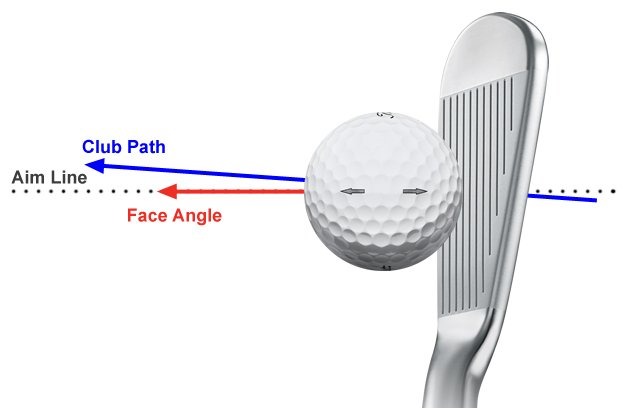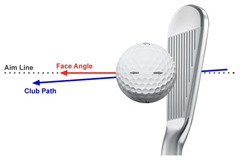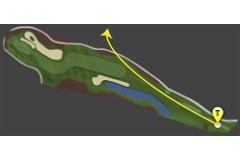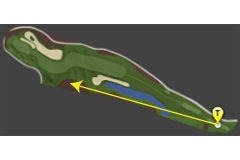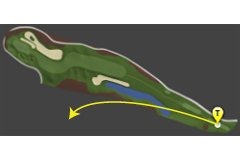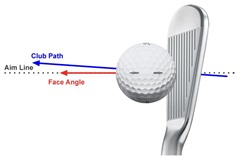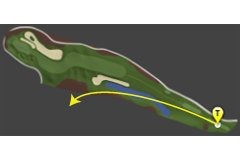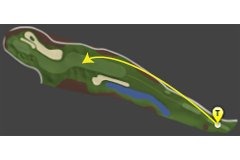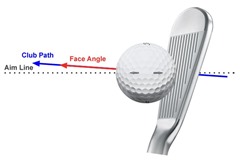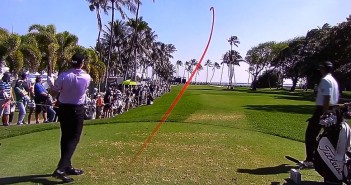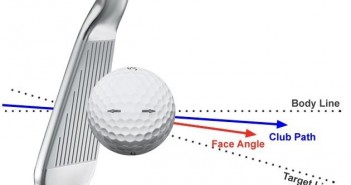Learning how to analyse your ball flight to determine your swing faults, and to create the impact conditions that will produce the shot shapes you desire, requires control over your swing path and the club face through impact.
Until fairly recently, golf teachers didn’t understand how club path and face angle combined to determine the initial direction and curvature of the golf ball’s flight. They completely overemphasised the influence of the club path, and underemphasised the influence of the club face.
It is the club face that primarily determines the starting direction of the golf ball, and it’s the club path, relative to the face angle, that bends the ball left or right. If anyone tells you otherwise, they need to go back to school.
The club face starts the ball, the club path curves it.
Under normal circumstances, with a clean strike, the initial direction of the golf ball’s flight is 85% determined by the angle of the club face, and only 15% by the club head path.
If the club head path is to the right of the face angle, this will tilt the spin axis of the golf ball to the left, which will cause the ball to curve left in flight – it creates “draw spin”.
If the path is to the left of the face angle, the spin axis of the golf ball will be tilted right, and the ball will curve right – “fade spin”.
The greater the difference between the face angle and the club head path, the more the spin axis will be tilted, and so the more the ball will curve in flight.
Increasing the difference between the face angle and the club head path will also reduce the efficiency of the strike, it is a “glancing blow”. This is mitigated, to some extent, when the club head path is from the inside of the face angle, since this “closed face” will produce less dynamic loft and thus a relatively more efficient strike.
There are nine basic combinations of club face angle (straight, left, right) and club path (straight, left, right), and the effect on ball flight of each combination is described below.
The directions are described for a right-handed golfer, and are given relative to an “aim line”. The aim line is the line that your body is aligned parallel to when you play the shot – for a straight shot it would be the same as the target line.
Outside Path & Square Club Face
The classic slice, you’ll be playing your next shot from the rough.
You’ve squared the club face okay, so the ball will start straight, but your over-the-top swing has brought the club head in from outside your aim line, so the club head is moving to the left of the club face through impact, which will tilt the ball’s spin axis to the right and the ball will curve right.
You could play a fade this way, if you aimed way left, but the over-the-top move is very inefficient and difficult to control. You’re better off playing a fade with a square path and an open face, as described below – see Figure 5c.
Outside Path & Open Club Face
Fore right!!!
A huge slice, bye bye ball, you’ll be playing three off the tee (or from the wrong fairway!)
You’ve left the club face open, so the ball will start right, and your over-the-top swing has brought the club head in from outside your aim line, so the club head is moving well to the left of the club face through impact, which will tilt the ball’s spin axis to the right and the ball will curve further right.
Outside Path & Closed Club Face
The classic, and very horrible, pull.
You’re probably fighting a slice, maybe you’ve been told to strengthen your grip to try and get the club face square through impact, but unfortunately you’ve not fixed your over-the-top swing. The face is square all right, but square to an outside-in path… ugly!
It’s a fairly efficient strike, so you’ll hit the ball further than usual… into the rough!
The club face and path are both sending the ball straight left, hopefully your playing partners will help you look for it in the rough over there.
Square Path & Square Club Face
The perfect combination for ball striking efficiency and control. It’s a long walk up the short stuff for you, well done!
Square Path & Open Club Face
If you did this on purpose, and you were aiming far enough left, then this is the classic fade.
The open club face will start the ball right, and the club path is square to your aim line, so the club head is moving to the left of the club face through impact, which will tilt the ball’s spin axis to the right and the ball will curve further right.
Square Path & Closed Club Face
You’ve slammed the club face shut, maybe you got a little stuck in the downswing and tried to rescue it with your hands, but you overcooked it. You’ll be looking for your ball in the left rough, and the draw-spin will have made sure the ball rolled nice and deep into the thick stuff! Good luck with that!
The closed club face will start the ball left, and the club path is square to your aim line, so the club head is moving to the right of the club face through impact, which will tilt the ball’s spin axis to the left and the ball will curve further left.
You could play a draw this way, if you aimed way right, but it’s not easy to control and the impact dynamics aren’t very efficient. You’re better off playing a draw with an inside path and a square face, as described below – see Figure 7c.
Inside Path & Square Club Face
If you did this on purpose, and you were aiming far enough right, then this is the classic draw.
The square club face will start the ball straight, and the club path is from inside your aim line, so the club head is moving to the right of the club face through impact, which will tilt the ball’s spin axis to the left and the ball will curve left.
The inside attack combined with a square face makes this the most efficient and controllable way to hit a draw.
Inside Path & Open Club Face
The classic push. This tends to be a better player’s fault. You’re attacking the ball from the inside, but your timing was slightly out and you didn’t square the club face in time.
The club face and path are both sending the ball straight right, and your next shot will be from the rough – assuming there’s not too much trouble over there!
Inside Path & Closed Club Face
Fore left!!!
The big hook! An all-too common fault amongst better players. You’ve slammed the club face shut, you probably got stuck in the downswing and tried to rescue it with your hands, but you completely overcooked it. You might find your ball, if you’re lucky, but you should take a provisional!
The closed club face will start the ball left, and the inside club path means that the club head is moving way to the right of the club face through impact, which will tilt the ball’s spin axis to the left and the ball will curve further left.
Obviously, there are many more subtle variations of face angle and path that you can use to create the shot shape that you desire, and we also need to discuss the vertical dimension of the ball’s trajectory (high or low). But understanding the basic combinations described above will help you to work the ball as you desire.
To learn how to create the impact conditions that you need to play every shot, start with the Shot Making series.
For an interesting example of how to use this information to play a speciality shot, see What is a Power Fade, and How Do I Play One?
» The Mechanics of Golf Ball Flight.

